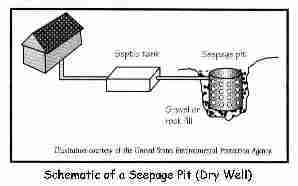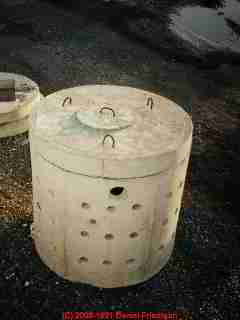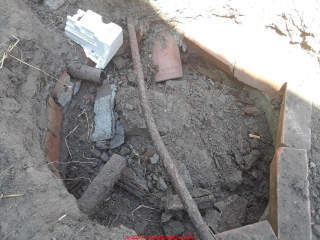 Drywell FAQs
Drywell FAQs
Q&A on design, construction, use of drywells or pits
- POST a QUESTION or COMMENT about drywells, seepage pits, and graywater disposal
Drywell or seepage pit construction & use FAQs.
This article series explains what a drywell (or seepage pit) is, describes how drywells are used, gives safety and maintenance advice for drywells, and defines the criteria for drywell failure.
InspectAPedia tolerates no conflicts of interest. We have no relationship with advertisers, products, or services discussed at this website.
- Daniel Friedman, Publisher/Editor/Author - See WHO ARE WE?
Drywell or seepage pit FAQs
 These questions & answers about how to design, build, use or troubleshoot drywells used to dispose of graywater or surface water were posted originally at x - please be sure to read that article too.
These questions & answers about how to design, build, use or troubleshoot drywells used to dispose of graywater or surface water were posted originally at x - please be sure to read that article too.
On 2018-05-08 by (mod) - stay safe around old drywells, seepage pits, cesspools, septic tanks
Thank you for your very nice note. Means a lot.
I agree that the best approach is to completely fill in the old cesspool which of course will eliminate any falling in Hazard.
Details are at CESSPOOL SAFETY WARNINGS
On 2018-05-08 by Raul
I appreciate you. It has 1 - 4" ceramic pipe and 2 - 2 1/2 steel pipe that enter into this cesspool. Reading the Safety advisories I feel pretty fortunate not to have suffered the "ugly death." While tilling on the property, as I was shoveling, my shovel dropped 2' and out of my hands.
Curiosities of course wanted to dig in further.
But... After reading both the property owner and me agree to toss a penny for luck re-pack it, better cover and build a mock well over it. Thanks for being there you may have saved a life.
SINCERELY,
RAUL RUIZ JR
On 2018-05-06 by (mod) -
Raul
I see a dirt, mud, and debris-filled hole that looks like a site-built seepage pit or drywell that has been filled-in and is certainly not usable. I can't quite make out the dimensions of the entering pipes. If the larger one is 3" ID or greater then this may have indeed been a cesspool.
On 2018-05-06 by Raul Ruiz
Sorry more in formation as to home inwich well is on. Family home built 1950. Land is in Stockton California, and was agricultural land prior to re-zoning.
I am trying (without further excavation) to determine if the well I unearthed is drywell or cesspool?
On 2018-04-27 by (mod) - Pumping a drywell does little to extend its life and can be dangerous i
Yes.
Pumping a drywell does little to extend its life and can be dangerous if the drywell is constructed such that it could collapse. If someone falls in they could be injured or worse.
On 2018-04-27 by Gretchen
If a dry well was pumped 12 years ago, and now is almost full, does that mean it is not functioning properly?
On 2017-11-29 by (mod) -
Posting Q&A received by private email
Hi,
I have a home in NC built in 66. There is a septic tank for the bathroom and all the fixture in there but the washing machine and the kitchen sink are grey water drains from the original construction.
The house is on a concrete slab and the grey water drains are on the opposite side of the house from the septic tank. I am now trying to sell this home and my realtor is telling me we cant sell the house with a grey water drain of any type and there isn't any grandfather for the situation.
trying to resolve the grey water drain is going to cost about $4000 and we don't have that in the budget. Is it true that in NC you cant sell a house with a grey water drain?
It seems to me that as long as its disclosed and the buyer agrees to deal with it then it would be fine. But my realtor is insisting it cant be sold with the grey water drains intact.
Thanks in advance for the information. - anonymous by private email
Reply:
OPINION:
"Can't sell" probably deserves some more-careful explanation - best to come from your realtor. In my experience, even where there is no law forcing a home seller to do anything to fix or repair a home, some older or outdated or defective components or systems can become a stumbling block in the sale of the home because the buyer's bank might, on learning of the issue, say they won't give a mortgage until the item is repaired.
The bank is protecting itself against ending up holding an expensive bag.
There is always a solution - like obtaining a construction loan or bridge loan, or granting an allowance to a buyer. But for a buyer who's not got a lot of cash reserve and is dependent on a bank who really doesn't care a fig about either of you, you can indeed run into a "can't sell" issue.
On 2017-04-19 by (mod) -
Travis,
Thanks for the comment, your suggestion is excellent.
On 2017-04-19 by Travis
I installed a dry well with new construction in order to keep salty discharge from our water softener out of our septic system (when the water softener cycles). Works great, though I guess at some point the salt in the subsoil could accumulate enough to kill vegetation. 11 years on, no problems. Just another suggested application for a dry well.
On 2016-07-10 by (mod) - What sources of wastewater are acceptable for a drywell?
Ted, at GREYWATER SYSTEMS https://inspectapedia.com/septic/Greywater_Systems.php you'll find a more detailed definition of "greywater" - generally wastewater that is not from toilets, though I'd watch out about including kitchen sink drainage if a garbage grinder is in use. Toilet waste including feces and toilet tissue are "blackwater" and need the additional breakdown-processing that occurs in a septic tank or sewage treatment system.
On 2016-07-10 by Ted
What sources of wastewater are acceptable for a drywell? Shower? Dishwashing, etc.
On 2015-05-10 by (mod) -
Ian
Is it possible that surface water or ground water are running back into your graywater disposal system?
On 2015-05-02 by Ian
hi I have a grey well system and it pumps out to the weeping tiles for the last mth now water is continually running in well not sure what or why this is happening don't think the weeping tiles are froze any idea as to what could be wrong
...
Continue reading at DRYWELL SAFETY CONCERNS or select a topic from the closely-related articles below, or see the complete ARTICLE INDEX.
Or see these
Recommended Articles
- CESSPOOLS
- CESSPOOL FAILURE CRITERIA
- CESSPOOL SAFETY WARNINGS
- CISTERNS, WATER STORAGE
- DRYWELL DESIGN & USES
- DRYWELL SAFETY CONCERNS
- DRYWELLS ARE THEY ACTUALLY DRY?
- DRYWELL / SEEPAGE PIT SPECIFICATIONS
- DRYWELL / SEEPAGE PIT COLLAPSE or FAILURE
- GREYWATER SYSTEMS
- SEEPAGE PITS
- SEPTIC TANKS - home
Suggested citation for this web page
DRYWELL DESIGN & USE FAQs at InspectApedia.com - online encyclopedia of building & environmental inspection, testing, diagnosis, repair, & problem prevention advice.
Or see this
INDEX to RELATED ARTICLES: ARTICLE INDEX to SEPTIC SYSTEMS
Or use the SEARCH BOX found below to Ask a Question or Search InspectApedia
Ask a Question or Search InspectApedia
Try the search box just below, or if you prefer, post a question or comment in the Comments box below and we will respond promptly.
Search the InspectApedia website
Note: appearance of your Comment below may be delayed: if your comment contains an image, photograph, web link, or text that looks to the software as if it might be a web link, your posting will appear after it has been approved by a moderator. Apologies for the delay.
Only one image can be added per comment but you can post as many comments, and therefore images, as you like.
You will not receive a notification when a response to your question has been posted.
Please bookmark this page to make it easy for you to check back for our response.
Comments
IF above you see "Comment Form is loading comments..." then COMMENT BOX - countable.ca / bawkbox.com IS NOT WORKING.
In any case you are welcome to send an email directly to us at InspectApedia.com at editor@inspectApedia.com
We'll reply to you directly. Please help us help you by noting, in your email, the URL of the InspectApedia page where you wanted to comment.
Citations & References
In addition to any citations in the article above, a full list is available on request.
- In addition to citations & references found in this article, see the research citations given at the end of the related articles found at our suggested
CONTINUE READING or RECOMMENDED ARTICLES.
- Carson, Dunlop & Associates Ltd., 120 Carlton Street Suite 407, Toronto ON M5A 4K2. Tel: (416) 964-9415 1-800-268-7070 Email: info@carsondunlop.com. Alan Carson is a past president of ASHI, the American Society of Home Inspectors.
Thanks to Alan Carson and Bob Dunlop, for permission for InspectAPedia to use text excerpts from The HOME REFERENCE BOOK - the Encyclopedia of Homes and to use illustrations from The ILLUSTRATED HOME .
Carson Dunlop Associates provides extensive home inspection education and report writing material. In gratitude we provide links to tsome Carson Dunlop Associates products and services.


